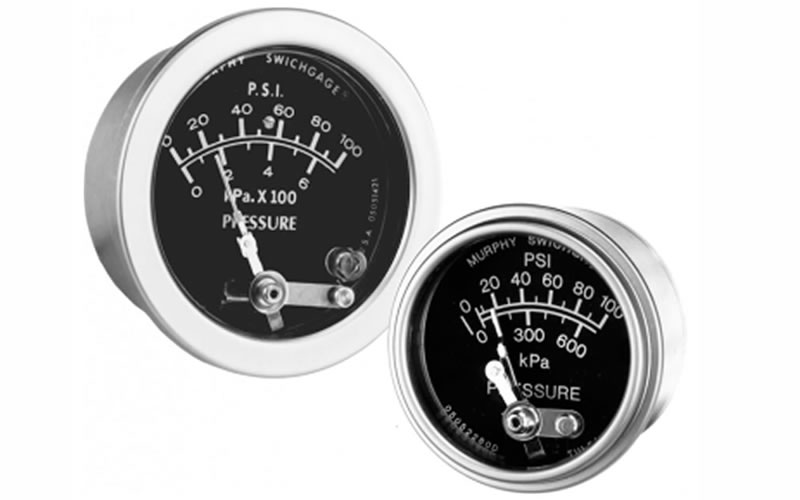Digital Industrial Pressure Gauges
20P - 25P Series Mechanical Pressure Gauges
The 20P - 25P Series Mechanical Pressure Gauges are precision instruments designed for reliable pressure measurement in various industrial applications. These gauges feature a robust mechanical design that provides accurate readings without the need for an external power source. Ideal for monitoring pressures in systems like hydraulics, pneumatics, and gas, the 20P - 25P series offers durability and consistency in performance. With clear, easy-to-read displays and a wide range of measurement options, these gauges are essential tools for maintaining system safety and efficiency in demanding environments.
The 20P - 25P Series Mechanical Pressure Gauges are a type of analog pressure gauge typically used in various industrial, automotive, and mechanical applications to measure and display pressure within a system. These gauges are part of a series that is generally used for applications where durable, accurate, and reliable measurement of pressure is needed in non-electrical environments.
The 20P Series (2 inch/51 mm dial) and the 25P Series (2-1/2 inch/64 mm dial) Swichgauge models are diaphragm-actuated, pressure-indicating gauges with built-in electrical switches. These switches are used for tripping alarms and/or shutdown devices.
The 20P - 25P Series Mechanical Pressure Gauges are robust, reliable, and simple devices designed for accurate pressure measurement in a variety of applications. Whether you're working in industrial settings, automotive performance, HVAC, or other fields, these gauges provide a reliable, low-maintenance solution for pressure monitoring. They’re ideal for environments where electrical gauges may be impractical or undesirable, offering durability, accuracy, and ease of use.
Here’s a breakdown of the 20P - 25P Series Mechanical Pressure Gauges:
Key Features of 20P - 25P Series Mechanical Pressure Gauges:
1. Mechanical Operation:
Like other mechanical pressure gauges, the 20P - 25P series uses a mechanical mechanism, usually a Bourdon tube or diaphragm, to measure pressure.
When pressure is applied to the sensor (Bourdon tube or diaphragm), it deforms, causing the attached pointer to move across a calibrated scale to indicate the pressure.
2. Pressure Ranges:
The 20P - 25P Series often features pressure ranges that can span from vacuum to high pressures, depending on the specific gauge model.
Common ranges can vary from as low as 0-30 psi up to several thousand psi, with some models being able to handle both low and high-pressure applications.
The specific range for your needs would depend on the model and type of application.
3. Dial Size and Display:
The dial size of the 20P - 25P Series typically ranges from 2 inches (50mm) to 4.5 inches (115mm) in diameter.
The gauge face is typically marked with clear numerical graduations, and some models have color-coded zones (green, yellow, red) to indicate safe, caution, or dangerous pressure ranges.
4. Accuracy:
Mechanical pressure gauges like those in the 20P - 25P series are known for their reliable accuracy, typically offering +/- 2.5% or +/- 3% full-scale accuracy, though this can vary depending on the specific gauge and manufacturer.
5. Durable Construction:
These gauges are designed for durability in tough industrial environments, with stainless steel or brass housings, and brass or stainless steel internals for increased resistance to corrosion and wear.
The crystal on the front of the gauge may be made from plastic or glass, depending on the model.
6. Fluid Compatibility:
Many of the 20P - 25P Series gauges are liquid-filled, which helps dampen the needle movement, providing smoother readings and reducing the effects of vibration. This is especially useful in environments where vibration might cause needle instability.
Depending on the model, the gauges can be filled with glycerin, silicone, or other oils for damping.
7. Mounting Options:
These mechanical pressure gauges can typically be mounted in several ways, including front mount, back mount, or panel mount configurations.
This flexibility allows the gauges to be installed in a variety of machinery, automotive, and industrial systems.
Common Applications of 20P - 25P Series Mechanical Pressure Gauges:
1. Industrial Machinery:
These gauges are commonly used in hydraulic systems, compressors, pumps, and boilers where precise pressure readings are essential for safety and performance.
2. Automotive & Marine:
They are often used in automotive applications to monitor pressures in fuel systems, coolant systems, or other pressure-sensitive components. In marine applications, they can be used to monitor oil, fuel, or cooling system pressures.
3. HVAC Systems:
Mechanical pressure gauges are frequently used in heating, ventilation, and air conditioning (HVAC) systems for measuring refrigerant pressures.
4. Oil & Gas:
Used extensively in the oil and gas industry to measure pressures in pipelines, drilling rigs, and other pressure-regulated systems.
5. Laboratories and Research:
In scientific research, mechanical pressure gauges can be used for precise pressure measurements in laboratory systems, where accurate data is necessary.
Benefits:
No Power Required: Since these gauges are entirely mechanical, they don’t require electricity, making them highly reliable in environments where electrical power could be unreliable or unavailable.
Rugged and Durable: Built to handle rough conditions, including vibrations, pressure surges, and temperature fluctuations, mechanical gauges are often more durable than electronic alternatives in certain industrial settings.
Simplicity and Cost-Effectiveness: Mechanical gauges are relatively simple in design, meaning they’re typically more affordable and easier to maintain or replace than digital or electronic gauges.
Limitations:
Limited Features: Unlike digital gauges, mechanical models typically do not offer advanced features such as data logging, remote monitoring, or high-tech displays.
Manual Calibration: Mechanical gauges often require manual calibration if they become inaccurate, and calibration needs to be done periodically for precise readings.
Potential for Wear: The mechanical components inside the gauge can wear out over time due to friction, corrosion, or mechanical stress, potentially requiring maintenance or replacement.


